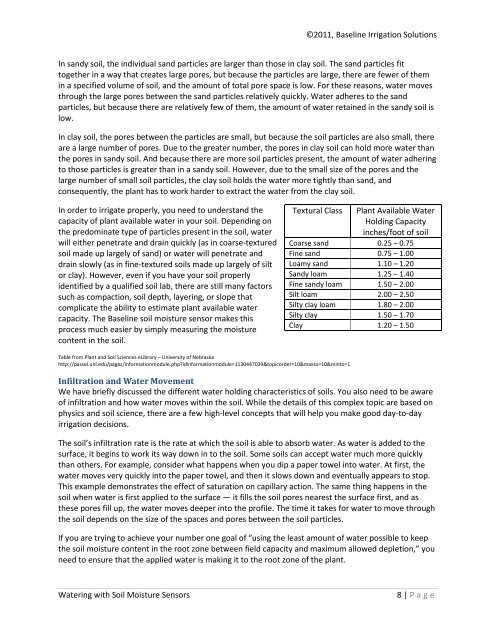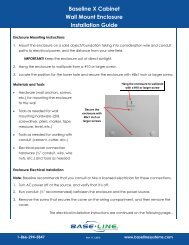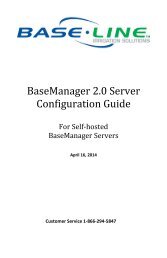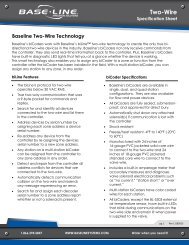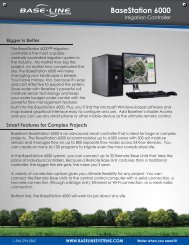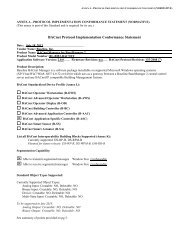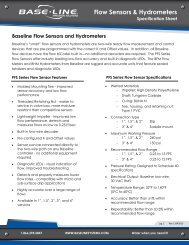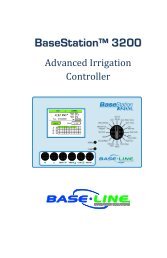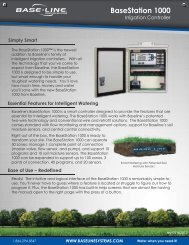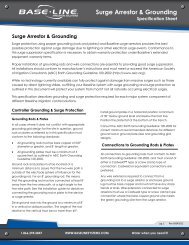Watering with Soil Moisture Sensors - Baseline Systems
Watering with Soil Moisture Sensors - Baseline Systems
Watering with Soil Moisture Sensors - Baseline Systems
Create successful ePaper yourself
Turn your PDF publications into a flip-book with our unique Google optimized e-Paper software.
©2011, <strong>Baseline</strong> Irrigation SolutionsIn sandy soil, the individual sand particles are larger than those in clay soil. The sand particles fittogether in a way that creates large pores, but because the particles are large, there are fewer of themin a specified volume of soil, and the amount of total pore space is low. For these reasons, water movesthrough the large pores between the sand particles relatively quickly. Water adheres to the sandparticles, but because there are relatively few of them, the amount of water retained in the sandy soil islow.In clay soil, the pores between the particles are small, but because the soil particles are also small, thereare a large number of pores. Due to the greater number, the pores in clay soil can hold more water thanthe pores in sandy soil. And because there are more soil particles present, the amount of water adheringto those particles is greater than in a sandy soil. However, due to the small size of the pores and thelarge number of small soil particles, the clay soil holds the water more tightly than sand, andconsequently, the plant has to work harder to extract the water from the clay soil.In order to irrigate properly, you need to understand thecapacity of plant available water in your soil. Depending onthe predominate type of particles present in the soil, waterwill either penetrate and drain quickly (as in coarse-texturedsoil made up largely of sand) or water will penetrate anddrain slowly (as in fine-textured soils made up largely of siltor clay). However, even if you have your soil properlyidentified by a qualified soil lab, there are still many factorssuch as compaction, soil depth, layering, or slope thatcomplicate the ability to estimate plant available watercapacity. The <strong>Baseline</strong> soil moisture sensor makes thisprocess much easier by simply measuring the moisturecontent in the soil.Textural Class Plant Available WaterHolding Capacityinches/foot of soilCoarse sand 0.25 – 0.75Fine sand 0.75 – 1.00Loamy sand 1.10 – 1.20Sandy loam 1.25 – 1.40Fine sandy loam 1.50 – 2.00Silt loam 2.00 – 2.50Silty clay loam 1.80 – 2.00Silty clay 1.50 – 1.70Clay 1.20 – 1.50Table from Plant and <strong>Soil</strong> Sciences eLibrary – University of Nebraskahttp://passel.unl.edu/pages/informationmodule.php?idinformationmodule=1130447039&topicorder=10&maxto=10&minto=1Infiltration and Water MovementWe have briefly discussed the different water holding characteristics of soils. You also need to be awareof infiltration and how water moves <strong>with</strong>in the soil. While the details of this complex topic are based onphysics and soil science, there are a few high-level concepts that will help you make good day-to-dayirrigation decisions.The soil’s infiltration rate is the rate at which the soil is able to absorb water. As water is added to thesurface, it begins to work its way down in to the soil. Some soils can accept water much more quicklythan others. For example, consider what happens when you dip a paper towel into water. At first, thewater moves very quickly into the paper towel, and then it slows down and eventually appears to stop.This example demonstrates the effect of saturation on capillary action. The same thing happens in thesoil when water is first applied to the surface — it fills the soil pores nearest the surface first, and asthese pores fill up, the water moves deeper into the profile. The time it takes for water to move throughthe soil depends on the size of the spaces and pores between the soil particles.If you are trying to achieve your number one goal of “using the least amount of water possible to keepthe soil moisture content in the root zone between field capacity and maximum allowed depletion,” youneed to ensure that the applied water is making it to the root zone of the plant.<strong>Watering</strong> <strong>with</strong> <strong>Soil</strong> <strong>Moisture</strong> <strong>Sensors</strong>8 | P age


